Life is a complex and mysterious phenomenon. Feynman once said, “What I can’t create, I do not understand.” To truly understand life, the best approach might be to create it. The urge to create life transcends different civilizations and permeates human history. This is evident from the golems of ancient Jewish folklore, the Talos of ancient Greece, and Yanshi of the Zhou Dynasty in China, to literary works like Frankenstein and modern science fiction.Today, this urge is driven not only by the need for functionality or productivity but also by advancements in technology. Particularly in the fields of artificial life and artificial intelligence, it has made significant contributions to understanding ourselves and our existence in the universe.
Artificial Life (Alife) is an emerging interdisciplinary research field that aims to explore various potential forms of life through computational models and physical simulations. Alife seeks not only to simulate and replicate known forms of life on Earth but also to create entirely new, possible life forms, thereby expanding our understanding of the concept of “life.” This includes using computer simulations to model life processes, studying self-organizing systems, and developing software and hardware systems that can simulate natural selection and evolutionary processes. This article will review the history of Alife and introduce its latest research directions and practical advancements.
1.From Life to Alife
In traditional biology, life is typically considered a natural system composed of DNA and proteins, characterized by metabolism, reproduction, development, genetic evolution, and other traits. It wasn’t until 1944, when physicist Erwin Schrödinger published “What Is Life?”, that life was redefined beyond specific physiological structures as an energy-information coupled negentropic system. This concept not only addressed past theories but also resonated with contemporary thinking, bridging organicism and mechanism, and laying the theoretical groundwork for the study of Alife.
Around the same time, scientists from various fields began exploring Alife, which can be divided into three waves:
The First Wave: Exploration of Self-Replication (1950s-1960s)
During this period, scientists focused on the fundamental principles of self-replication, self-organization, and evolution, which sustain and generate the structure of life. Areas involved included cybernetics, Turing machines, morphogenesis, neural network models, and genetic algorithms. Notably, John von Neumann’s 1948 work on self-replicating automata laid the foundation for the discipline of artificial life.
In this wave, scientists viewed life as a form of logic, emphasizing abstract models of information processing. Practically, Norwegian mathematician Nils Barricelli used one-dimensional cellular automata on early computers (IAS) between 1953-1962 to simulate a digital world capable of indefinite evolution, even observing digital symbiotic life forms. He posited that Darwin’s theory of competitive evolution was insufficient to explain the entirety of life’s evolution, highlighting the significant roles of symbiosis and cooperation [1]. This wave clarified life’s fundamental characteristics through models and algorithms, dispelling myths about life’s origins and establishing the theoretical and practical foundation for artificial life.
The Second Wave: Computational Simulation Period (1970s-1990s)
During this period, scientists extensively utilized computational simulation technologies, including cellular automata, neural networks, and digital evolutionary systems, to study characteristics of life systems such as adaptability and emergence.
In September 1987, Christopher Langton organized the first Artificial Life Conference, marking the birth of the discipline. Alife was defined as the study of “life as it could be,” [2] in contrast to traditional biology’s focus on known life forms on Earth. Von Neumann’s cellular automata, further developed by John Conway (Game of Life), Stephen Wolfram, and Langton himself, became one of Alife’s most crucial theoretical models.
Langton defined a cellular automaton activity parameter λ, where an intermediate value of λ results in automata exhibiting both localized stable patterns and unorganized chaotic behavior, known as the “edge of chaos.” He suggested that life or intelligence originates from this “edge of chaos,” an important concept in complex systems theory. This wave advanced computational simulation techniques to study complex system characteristics like adaptability and emergence, marking the establishment of the Alife discipline and the beginning of engineering practice.
The functionalist stance and abstract model simulations of the first two waves helped capture the universal essential features of life. As Langton believed, life is an appropriate form independent of its substrate, meaning different materials can achieve the same life and intelligence functions [3]. Consequently, the main outcomes of these waves were software/virtual/digital artificial life (Soft Alife).

However, Alife research has always been accompanied by skepticism and reflection. Contemporary theoretical biologist Robert Rosen, in his 1991 work “Life Itself,” argued that life forms are “closed to efficient causation” (M,R) systems*[4], where the drivers of change must also be the products of the system. For example, enzymes in life systems catalyze metabolic reactions and produce themselves, creating a cyclical causal structure that grants life a certain autonomy and self-generative capability, implying that life forms cannot be entirely simulated by Turing machines.
(M,R) System: Metabolism (M) and Repair (R). Metabolism involves mechanisms (denoted as f) that transform materials A into products B, while repair involves mechanisms (denoted as Φ) that synthesize the metabolic mechanism f from the metabolic products B.
At the same time, biologist and cognitive scientist Francisco Varela also opposed Langton’s view [5]. He argued that the contextuality and historicity of organisms are irreducible and that the embodied interaction between organisms and their environment is more important than their underlying logic or functional patterns. These considerations led to the third wave of artificial life.
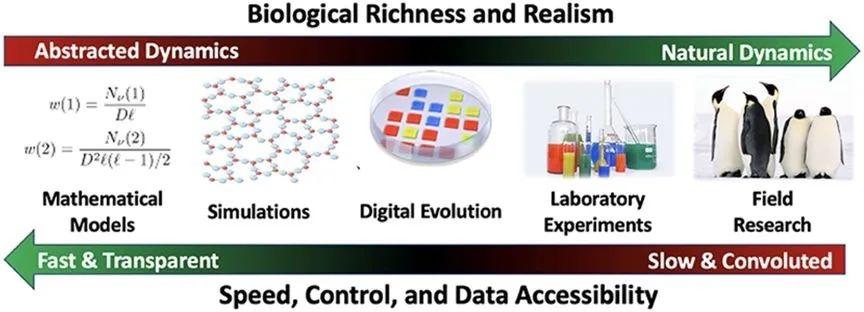
▷ Spectrum of Alife Research Methods: Abstract Models, Simulations, Digital Evolution, Biochemical Experiments, and Field Studies, Reflecting the Development from Abstract Models to Real-world Embedding, and the Soft, Hard, Wet, and Hybrid Paradigms. [6]
The Third Wave: Embedded Evolution Period (Late 1990s-Present)
This period’s research focuses more on the relationship between artificial life and real-world environments, emphasizing the embeddedness, embodiment, interaction, and emergence of life in the real world. In 1972 and 1991, Varela and collaborators introduced the concepts of autopoiesis and embodied mind, respectively, emphasizing the self-generative capacity of life systems and the dynamic, embedded emergent processes resulting from their embodied interactions with the environment. These ideas provided new theoretical perspectives for Alife research.
Researchers attempted to introduce “upward tension” within systems to avoid equilibrium states, construct self-referential evolution and dynamics [7], and incorporate the environment and the observer (e.g., attention and operation) into system function descriptions. Laboratory experiments aimed to drive systems to break through and generate innovative functions and behaviors within a self-organizing recursive loop, evolving toward broader directions in an ecosystem.
In addition to digital artificial life (Soft Alife), wetware (Wet Alife), hardware (Hard Alife), and hybrid artificial life (Hybrid Alife) became representative fields during this period. These included explorations in molecular-cellular level artificial chemistry, synthetic biology, self-replicating robots, and other areas, expanding research from artificial organisms to artificial ecosystems and societies. Even within digital artificial life research, scientists focused on digital embodied forms [8] and digital ecologies.

▷ EvoSphere: An autonomous evolutionary robotic system that continuously selects individuals capable of collecting nuclear waste in the environment. These individuals’ genotypes are then optimized through wireless “mating,” and new robot offspring are produced using 3D printing technology. [9]
Overall, the development of Alife can be divided into two axes: the horizontal axis represents technical implementation methods, from software computational simulations (Soft Alife) to physical hardware implementations (Hard Alife), biochemical experiments (Wet Alife), and bionic hybrid systems (Hybrid Alife). The vertical axis represents research focus, from artificial organisms to artificial ecosystems, open evolution, and symbiosis.

2. Artificial Ecosystems and Societies
In nature, organisms typically do not exist in isolation. For instance, many primates and social insects live in populations that coexist within ecosystems. Ecosystems, as the driving force behind the evolution of life, consist of the environment and all the organisms within it, forming dynamic systems filled with ecological interactions. Ecological research can be divided into community ecology, which focuses on interactions among biological populations, and ecosystem ecology, which examines interactions between organisms and their physical environment. Unlike simply creating artificial organisms, this branch of Alife studies collections of interacting artificial entities.
In natural ecological communities, different species interact with each other. In Alife, researchers often analyze community dynamics by viewing individuals as specific genotypes, phenotypes, or ecotypes. William Reiners [10] suggested that unified systems ecology research requires at least three independent and complementary theoretical frameworks: energetics, material science, and the evolution of population interactions or ecosystem “connectedness.” These frameworks can be understood respectively as energy flow, material flow, and causal information.
The flow and transformation of energy and materials include trophic levels, food chains and webs [11], productivity, and biogeochemical cycles (such as the carbon cycle). Population interactions or ecosystem connectedness encompass collective behaviors within populations [12], interactions among communities (such as predation, competition, and symbiosis), and niche studies exploring how these niches emerge, disappear, and evolve [13].
Theoretical techniques for studying the evolution of Alife artificial ecosystems mainly include complex dynamic systems, cellular automata, feedback networks, and cybernetics. Digital evolution simulation platforms provide tools for examining the dynamics of complex evolution and ecosystems.
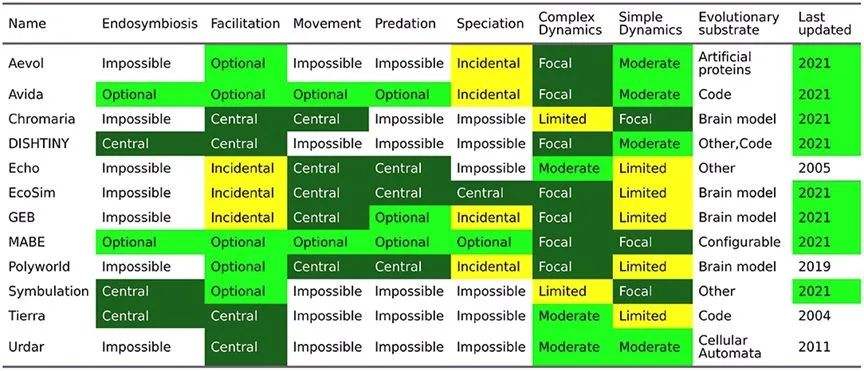
▷ Common Alife Digital Evolution Simulation Platforms. [6]
Some simulation platforms set up energy-material flow simulations. For example, in Tierra, energy is defined as the CPU cycles (computer processing time) required to execute instructions. Agents consume CPU cycles to execute instructions, altering their local environment. Minimizing energy consumption (CPU usage) can improve replication efficiency, exerting selective pressure on agents to evolve towards more efficient and reliable directions. In the Avida platform, organisms compete by metabolizing different limited resources (energy).
Alife ecological research systems differ from natural systems in that researchers can set parameters far beyond those commonly found in nature [15]. This allows researchers to explore which characteristics are essential for life and which traits and events might be mere coincidences of Earth’s life forms. Thus, Alife can not only “replay the tape of life” but also design and play tapes that run very differently from those on Earth (such as on Mars), helping to clarify and extract the essential properties of life.
Artificial ecological construction can be divided into four forms: soft, hard, wet, and hybrid artificial ecosystems. Alife digital platforms naturally simulate soft artificial ecosystems, including artificial life software systems or games and digital ecological art based on evolutionary computation. Hard artificial life ecosystems mainly involve the interaction of machine cluster systems. Wet artificial life ecosystems attempt to construct ecological communities composed of organisms that typically do not coexist, such as communities performing ideal tasks like waste decomposition and carbon sequestration. This subfield is known as synthetic ecology. As for hybrid artificial ecosystems, the most famous is the Flora Robotica project [16], which created a symbiotic ecosystem of plants and robots, where robots control plant growth by emitting different colored lights at different locations.

▷ Software, Wetware, and Hardware Artificial Ecosystems.
Research and practice in the field of artificial ecosystems are extensive. For example, as complexity increases, ecosystems can promote social and cultural interactions [17]. This involves interactions of predation, cooperation, and culture, sparking studies on perception, communication, and language [18]. Moreover, in the field of artificial intelligence, research on multi-agent systems and artificial collective intelligence can also be attributed to the study of artificial ecosystems and societies [19].
3. Open-Ended Evolution
“Nothing in biology makes sense except in the light of evolution.”
— Theodosius Dobzhansky, American evolutionary biologist
Driven by differential selection, populations and ecosystems that reproduce, inherit, and vary undergo Darwinian evolution. Evolutionary algorithms [20] use similar concepts to search for the optimal values of fitness functions in the external environment, often leading to unexpected results [21].
However, natural evolution is much more complex than artificial simulations at multiple levels, including genomic complexity, population size, number of generations, reproductive strategies (from horizontal gene transfer to sexual selection), the roles of gene regulation, development, and epigenetics, interactions among multiple co-evolving populations, and intrinsic definitions of fitness. These more natural evolutionary characteristics constitute the core content of Alife evolution research [14][22].
As Darwin said, “Endless forms most beautiful,” [23] Open-Ended Evolution (OEE) [24] is an important research area in Alife. OEE not only captures the fundamental characteristics of existing life systems, including their interactions with the environment, but also provides a framework to explore and simulate the possibility space of potential life forms. This can inspire various optimization, learning, and evolutionary algorithms during the research process. Thus, achieving OEE can be considered the ultimate goal of artificial life.
Unlike general evolution, an open-ended evolution system never settles into a single stable equilibrium, continuously generating novelty [25] and infinitely increasing complexity. This indicates that open-ended evolution represents a multi-scale evolutionary process [26]. The field of OEE involves questions about the origin of life [27], major evolutionary transitions in the emergence of complexity and organizational levels [28], and meta-evolution, which is the evolution of evolutionary capabilities and their evolution [29].
Several hypothetical conditions are necessary to produce open-ended evolution [30]:
(1) Infinite Genetic Space of Potential Genotypes: This does not mean the genome length of organisms must change indefinitely. Due to the slow mutation and inheritance rates of dominant genes, there may be a large number of regulatory genes for non-coding proteins, previously termed “junk DNA,” that quickly generate diversity by regulating the former. This implies that merely changing regulatory switches, similar to weights in neural networks, can quickly form new species. This hypothesis helps explain the common genes of the Last Universal Common Ancestor (LUCA) and the Cambrian explosion of life.
(2) Multiple Mutation Pathways Between Potential Phenotypes: This means that the potential characteristics of organisms should be producible by many different mutation pathways. For example, the eyes of humans and octopuses, though functionally similar, evolved independently; the fins of fish and dolphins are examples of convergent evolution. Theoretical biologist Stuart Kauffman illustrated this through random Boolean networks, finding that the ultimate behavior of gene regulatory networks is determined by the number of nodes and the in-degree 𝐾 of each node. When 𝐾=2, the network enters a state of edge-of-chaos, neither fixed-point, oscillating, nor completely chaotic. Each attractor in the network corresponds to a gene expression of a cell, indicating that different genomes can achieve the same adaptive phenotype through various evolutionary paths.
(3) Dynamic Adaptive Landscape: This means the environment surrounding organisms is constantly changing. On the one hand, as populations evolve, their environment changes with their behavior. On the other hand, the dynamic environment continuously selects the population, affecting genotype and phenotype realization through mechanisms like epigenetics.
Open-ended evolution can be studied using cellular automata, digital evolution simulation platforms like Tierra, Polyworld, Avida, and artificial chemistry [31] simulation platforms like Stringmol [32]. A 2019 study [33] identified three types of novelty and their corresponding openness based on the relationship between phenotypic behaviors and the search space of evolution:
Exploratory Openness: Novelty describable by current models, usually involving recombinations of existing components or modifications of existing parameter values. For example, new allele combinations in a genome might determine the number of vertebrae in new vertebrates.
Expansive Openness: Novelty requiring changes to the model but still using concepts existing within the current meta-model, involving discovering states that open new neighborhoods in the state space. This often involves utilizing previously untapped chemical or physical laws or the emergence of new boundary conditions or mechanisms. For example, the emergence of flight wings or visual sensory systems.
Transformational Openness: Novelty introducing new concepts, requiring changes to the meta-model. This involves not only new physical laws but also transitions at organizational levels. For instance, synthesizing a new chemical substance previously unused in metabolic reactions. The origin of life, eukaryotic cells, multicellular organisms, brains, self-awareness, writing, and technology belong to this category, often corresponding to strong emergence in complex systems.

▷ Three Types of Openness: Adaptation of Darwin’s finches to ecological niches; emergence of wings; eukaryotic cells.
Various metrics are used to detect [34] or quantify the potential for openness, such as the Measures of Open-Ended Dynamics (MODES) metric [35]. The effectiveness and applicability of these metrics have been verified in different experimental environments like the NK model and Avida digital evolution platform.

▷ Relationships Between MODES Indicators.
In MODES, the potential for complexity requires organisms to continuously integrate more environmental information into their genomes, generating increasingly complex behaviors. Ecological potential describes the ability of a population as a whole to absorb and reflect environmental information, including creating new niches and trophic levels through interactions with biotic and abiotic environments.
To achieve sustained open-ended change, environmental and ecological factors must be integrated into the evolution of organisms. Thus, open-ended evolution systems can be viewed as Rosen’s (M,R) systems. According to the description by the large language model ChatGPT, it prefers exploratory openness. Research in open-ended evolution is bound to provide important methods and paradigms for computational creativity and AGI research.
4. Symbiosis
“Nothing in evolution makes sense except in the light of parasitism,” states the title of a 2021 paper [36], echoing Dobzhansky’s famous description of evolution. This might not be an exaggeration. Numerous studies indicate that the evolution of the parasitism-mutualism continuum [37] is a crucial mechanism for generating biological novelty, shaping ecological diversity, and driving significant transitions in Earth’s life. As mentioned earlier, Nils Barricelli’s early Alife simulations recognized this phenomenon. Nick Lane, in “The Vital Question,” also argues that endosymbiosis increased the energy efficiency of life, facilitating the origin of eukaryotes and their eventual evolution into complex life on Earth.
Symbiosis can be seen as the result of intimate co-evolution at various ecological scales among organisms and populations [38]. Depending on spatial relationships, symbiosis can be divided into ectosymbiosis and endosymbiosis. Based on interspecies benefit relationships, symbiosis usually includes mutualism, commensalism, neutral interactions, amensalism, competition, and parasitism [39]/predation (broadly defined) [40]. Resource exchange-utilization dependency cycles in ecosystems can lead to community building and symbiotic evolution, even forming cross-feeding phenomena where the metabolic products of one species become the resources for another [41].
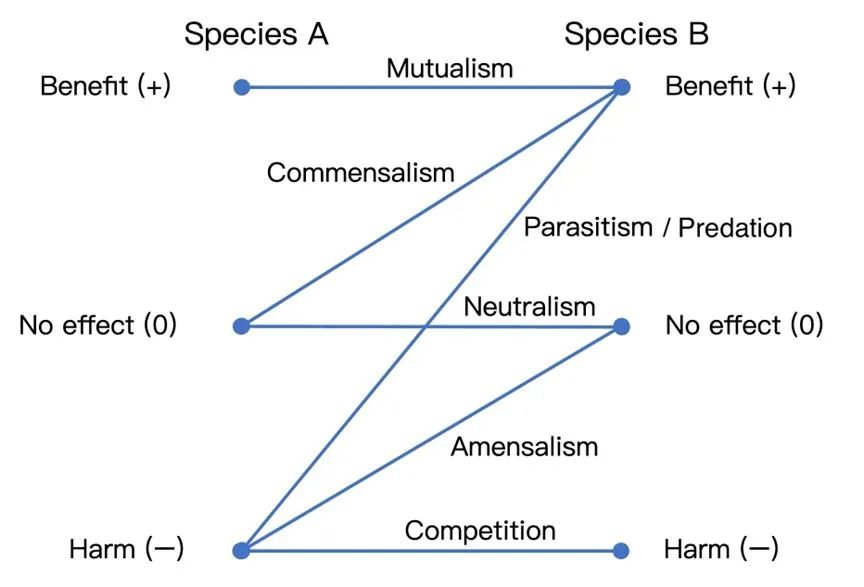
▷ Symbiotic Relationships [42]. The author combines figures from https://en.wikipedia.org/wiki/Symbiosis and [40] Figure 1.1.
Symbiosis can also be studied using the Game of Life and other digital evolution simulation platforms. For instance, researchers developed the Model-S [43] based on Conway’s Game of Life, which successfully simulated the evolution of self-organization, autopoiesis, multicellularity, the emergence of sexual reproduction, and species symbiosis fusion strategies. Studies found that even a small amount of symbiosis could significantly increase population fitness and potentially support open-ended evolution. In digital evolution systems supporting symbiosis [44], digital organisms survive and develop by consuming “CPU time” resources. Endosymbionts consume resources within the host, similar to mitochondria in real cells. Similarly, digital ribosomes transform digital genomes (binary code) into outputs or behaviors, akin to ribosomes in biological cells that read genetic codes and synthesize proteins.
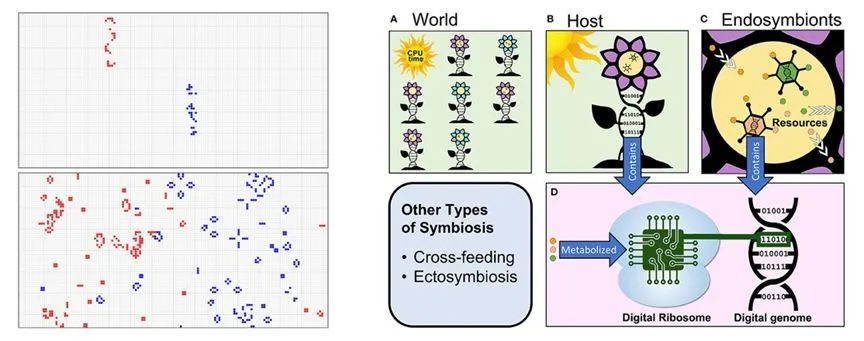
▷ Model-S Simulation of the Migration Game Producing a “Symbiotic Layer” [43] and the Simulation of Endosymbiosis in Digital Evolution Systems [44].
Life can be said to have been a symbiotic phenomenon from its origin, spanning different types of replicators from genes to culture (memes) to technology as extended phenotypes (techmemes). In the future, the fusion of biological and digital might enter a new era of human-machine symbiosis [45].
If the substrate of biological evolution is the natural physical environment, what is the substrate and ecological environment for the evolution of technobiological entities? Clearly, this must be a system interoperable by both human and machine life forms. Some studies suggest that [46] blockchain-based distributed systems possess characteristics such as environmental responsiveness, growth and change, genetic replication, and the ability to achieve homeostasis—many of which align with the definitions of life. When combined with AI technologies like neural networks, such systems could become self-organizing systems more advantageous than traditional life forms. Articles suggest that distributed virtual machines (dVMs) on public blockchains provide an open environment for autonomous evolution, supporting the development of artificial general intelligence (AGI).
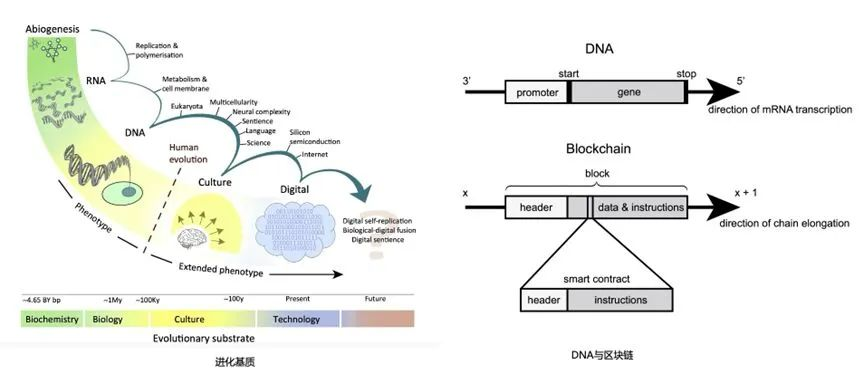
▷ Evolution of Evolutionary Substrates [45]; DNA and Blockchain [46].
Recently, a viewpoint known as Digital Matter Theory has emerged in the blockchain technology field, proposing that digital information can be viewed as a form of digital matter, akin to physical substances like wood or metal. By mining inherent patterns in blockchain data, a new form of digital matter can be created, termed the blockchain element table. It is seen as a representation of the material substrate and assets in the digital world. As block height increases, this digital world grows unpredictably, similar to the material world. In such systems, non-arbitrary resources/tokens (non-arbitrary, meaning the total amount is not human-defined or arbitrarily issued) can be created, providing the underlying logic and foundation for autonomous worlds and the metaverse.

▷ Digital Matter Theory, Autonomous Worlds, and the Blockchain Life Simulation Game Cellula [55].
Moreover, there are now blockchain-based Alife projects. For example, the blockchain life simulation game Cellula allows players to create various gene sequences and nurture their own “life” on the blockchain. In this game, block height acts as “time,” and each “life” grows, evolves, and dies within the blockchain space-time ecosystem. Since blockchain Alife involves both players and blockchain agent entities, it represents a typical form of reciprocal symbiosis. Additionally, some projects explore the potential of symbiosis between non-human entities like plants and digital or machine entities using blockchain technology or physical environments, such as the terra0 and Flora Robotica projects.
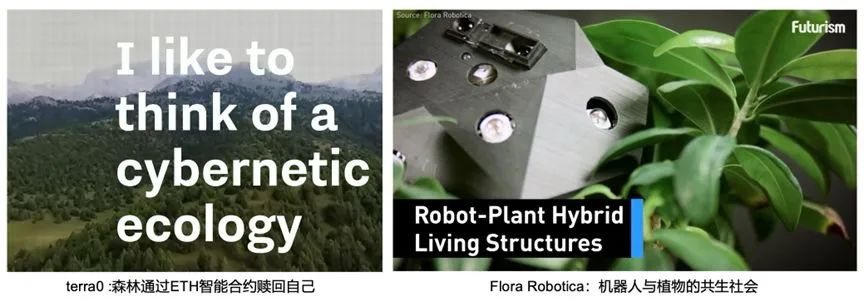
▷ Examples of Cross-media and Cross-species Symbiosis.
Of course, a more broadly discussed form of symbiosis is between humans and artificial intelligence. This primarily involves task and collaboration research, human-AI value alignment [47], and particularly the AI theory of mind [48]. These studies largely reflect anthropocentric views and symbiotic design considerations that prioritize human interests.
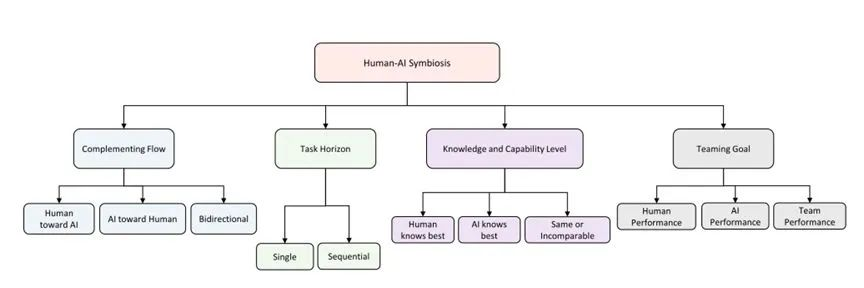
▷ Dimensions of Human-Machine Symbiosis Methods [49].
5. Biologically Inspired AI and the Future of Artificial Life
Looking back, it is evident that AI was long constrained by the limitations of symbolic artificial intelligence, or GOFAIstic [50]. In contrast, Alife and biologically inspired methods, also known as cybernetics-inspired approaches, have provided crucial insights and paradigms for the development of AI.
Geoffrey Hinton’s pioneering work on deep learning networks essentially simulates human brain neurons, while large models like Transformers emulate human brain memory and learning mechanisms to some extent. The hippocampal memory model of the human brain is akin to a causal Transformer with RNN positional encodings [51]. OpenAI, the creator of ChatGPT, constantly reminds its employees of the “bitter lesson,” firmly believing in the scaling law for emergent properties. They argue that only by continually increasing data and computational power can AGI be achieved. Reinforcement learning, including Reinforcement Learning from Human Feedback (RLHF), draws from animal behavior psychology and is fundamentally a feedback-based environmental adaptation mechanism. Generative Adversarial Networks (GANs) derive from ecological mechanisms of competition and symbiosis in animals.
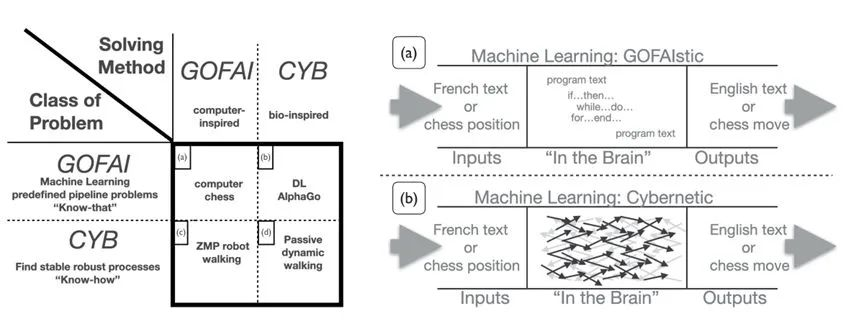
▷ GOFAI and Biologically Inspired (Cybernetic) AI [52].
With technological advancements, Alife researchers have continually explored various paradigms, from abstract models to computational simulations, embodied embedding, artificial ecosystems, and open-ended evolution, all driving further AI development. For example, Karl Friston’s Free Energy Principle and Yann LeCun’s Joint Embedding Predictive Architecture (I-JEPA) [53] attempt to integrate more biological principles into AI systems to enhance their interaction with the environment and autonomy. Even non-Von Neumann architectures, Hinton’s later proposal of mortal computation, the widely discussed human-AI value alignment, and ecologically inspired artificial intelligence [56] reflect the influence of Alife’s developmental trajectory.
Currently, generative AI, especially large language models, significantly impacts Alife research [54]. Large language models are used to explore the emergence of meaning, causal emergence, and open-ended evolution, particularly in human-machine collaboration, artificial collective intelligence, and multi-AI agent systems like the famous Stanford AI village. Additionally, there are algorithmic integrations such as neuroevolution, which combine neural networks and genetic algorithms. Researchers have used simple virtual organisms [57] with visual and auditory perceptions to interact with their environment, conspecifics, and predators, discovering that some individuals develop a “fear center” module to specifically respond to predators. This indicates that neural mechanisms akin to emotions and consciousness in biological brains can emerge in artificial substrates.
Finally, if we think in terms of the Alife paradigm, the questions before us are: How can blockchain-based systems and digital native substrates achieve autonomous (M,R) systems? How will large language models and AI agents evolve transformative openness? What kind of symbiotic relationship will AI and humans form—competition, endosymbiosis, or cross-species feeding? How will virtual reality and augmented reality impact future digital ecosystems?
Regardless of the future, Alife, AI, blockchain, and the metaverse (AR/VR/XR) will intertwine, leading to a symbiotic world of natural life and virtual entities, and digital and physical integration. In such a post-human era, life entities, in whatever form, will continue their journey of open-ended evolution in the boundless universe.